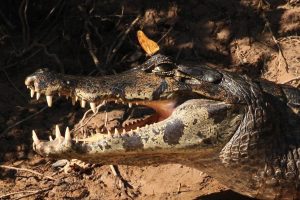2023 November 9
2023 November 9
The photograph below was sent to me (Jeremy Tatum) by a former student, who showed a touching faith in my ability to identify butterflies from a photograph of the underside of a butterfly photographed in Brazil. This is, of course, not remotely within the area normally covered by this site (Vancouver Island), but there are few (if any!) local butterflies to be seen just now, and this photograph is of quite exceptional interest. Apparently, Paul’s main intent was to photograph the caiman, and he didn’t know that there was a butterfly in the photograph until he examined it later. Still less did he know that he had photographed a remarkable behaviour.

Dryas julia (Lep.: Nymphalidae – Heliconiinae) Paul Coleman
My computer suggested that I reply to Paul with the words: I haven’t the slightest idea. I almost did that before it occurred to me that identification might actually be not impossible. The characteristic wing shape said immediately that it was from the nymphalid subfamily Heliconiinae. After that, options were rather limited. The colour, and what little can be seen of the pattern, and the locality, pointed strongly to Dryas julia. When we look at what the butterfly is doing, the identification is confirmed.
It was only recently discovered that the Julia butterfly slightly irritates the eyes of a caiman, causing it to cry, and the butterfly then “nectars” on these crocodile tears. So, without planning it, Paul had photographed this quite remarkable behaviour.
